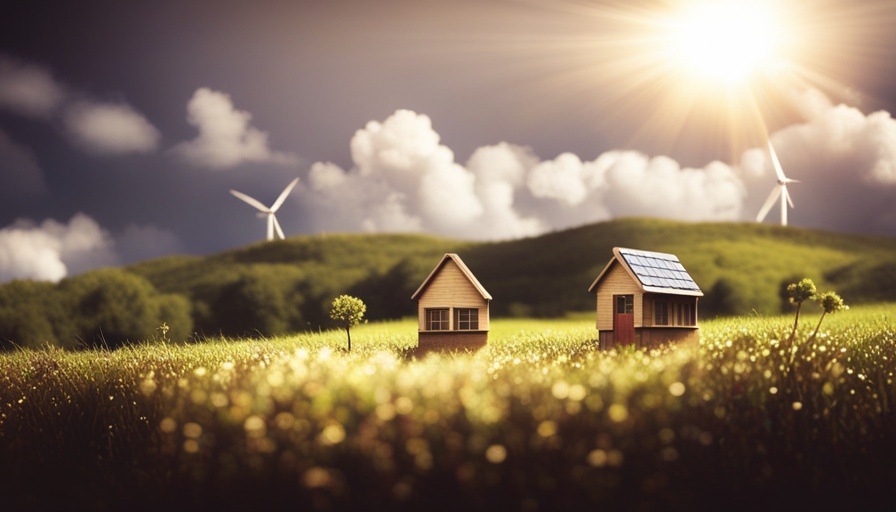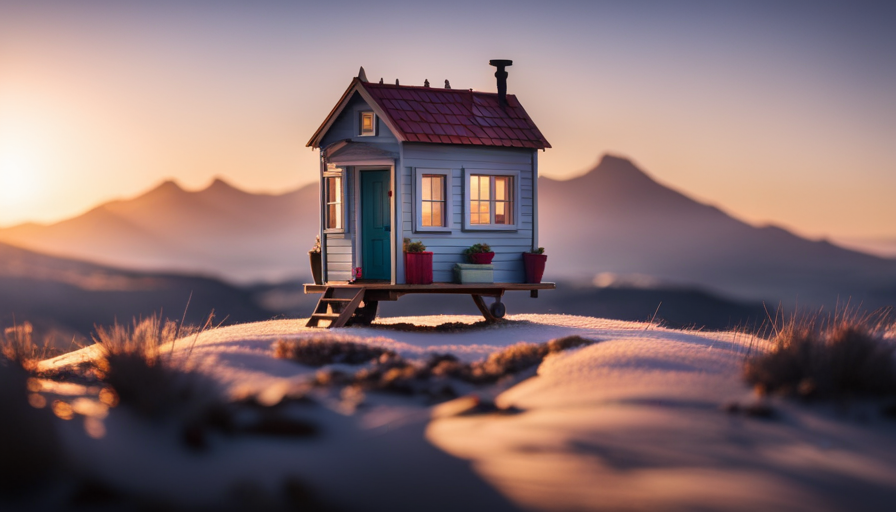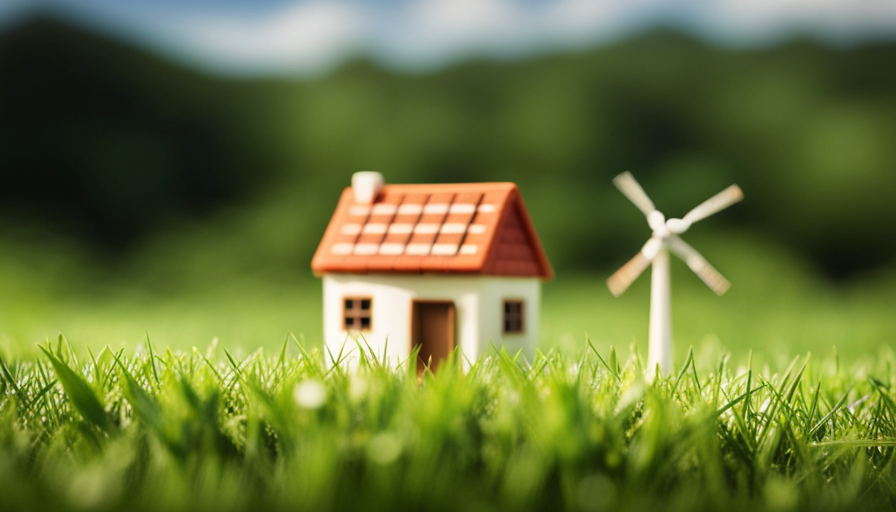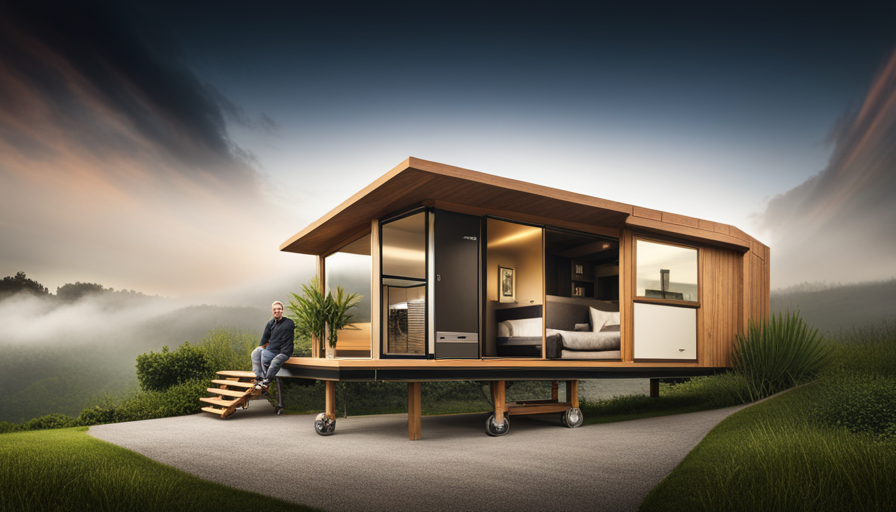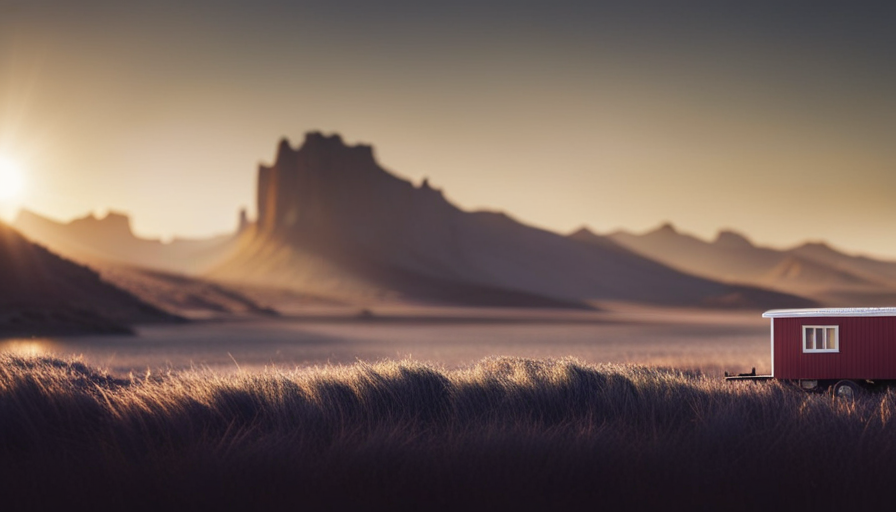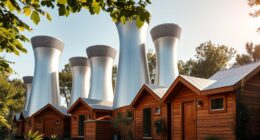In the vast world of housing, a tiny house stands out as a groundbreaking innovation, challenging conventional ideas about size and strength. Despite its small size, it shows impressive ability in meeting its energy requirements. Like a nimble gymnast, the tiny house performs a carefully orchestrated dance of energy sources, keeping itself well-lit and its appliances running smoothly.
Solar power, with its sun-kissed panels, takes center stage, harnessing the boundless energy of the sun to power the tiny abode. But the tiny house doesn’t stop there; it taps into the power of the wind, harnessing its invisible force to generate electricity.
Propane steps in, providing a reliable backup when the sun hides behind clouds. And with off-grid systems, battery storage, energy-efficient appliances, composting toilets, and rainwater harvesting, the tiny house becomes a self-sustaining oasis.
So come, step into the world of the tiny house, where power is harnessed in ingenious ways, and where small is truly mighty.
Key Takeaways
- Solar power and wind power are primary energy sources for powering tiny houses.
- Off-grid living can utilize renewable energy sources such as wind, geothermal, and biomass energy.
- Battery storage systems are crucial for storing excess energy and ensuring continuous power supply.
- Energy-efficient appliances, proper insulation, and power-saving techniques are essential for efficient power management in tiny houses.
Solar Power
You can power your tiny house with solar panels, which convert sunlight into electricity that can be used to run appliances and provide lighting. Harnessing solar energy is a sustainable and environmentally friendly way to generate power for your home.
Solar panel installation is a straightforward process that involves mounting the panels on the roof or any other area that receives ample sunlight. These panels consist of photovoltaic cells that absorb sunlight and convert it into DC (direct current) electricity. An inverter then converts this DC electricity into AC (alternating current) electricity, which can be used to power your appliances.
One of the advantages of solar power is its renewable nature. The sun’s energy is abundant and readily available, making it a reliable source of electricity. Additionally, solar power is clean and produces no greenhouse gas emissions, reducing your carbon footprint and contributing to a healthier environment.
In terms of maintenance, solar panels are relatively low-maintenance. They require occasional cleaning to remove dirt and debris that may accumulate on the surface. Monitoring the performance of the system and checking for any potential issues is also recommended.
Transitioning to the next topic, wind power offers another renewable energy option for powering your tiny house.
Wind Power
When it comes to powering a tiny house, harnessing wind energy is a viable option to consider. Wind turbines can be used to convert the kinetic energy of the wind into electricity, providing a sustainable and renewable source of power.
However, there are some important considerations to keep in mind when it comes to installing wind turbines for a tiny house. These considerations include the location and size of the turbine, as well as any local regulations or restrictions that may apply.
Harnessing Wind Energy for Tiny Houses
To power a tiny house, one option is harnessing wind energy, which can provide a sustainable and renewable source of electricity. Did you know that a single wind turbine can generate enough power to meet the energy needs of several tiny houses?
Wind energy is a viable solution for off-grid living, as it is abundant and readily available in many locations. By utilizing wind turbines, tiny house owners can tap into this clean and efficient energy source. In addition to wind power, other renewable energy options for tiny houses include harnessing geothermal energy and utilizing biomass energy.
However, when considering wind turbines for a tiny house, there are a few important considerations to keep in mind. These include the size and height of the turbine, local wind conditions, and any zoning regulations that may apply. By carefully considering these factors, tiny house owners can effectively harness wind energy to power their homes.
Considerations for Wind Turbines
One important factor to consider when utilizing wind turbines is the size and height requirements for optimal efficiency. The size of the turbine blades and the height at which they’re installed play a crucial role in harnessing wind energy effectively.
Turbines with larger blades can capture more wind energy, while taller installations can access stronger and more consistent wind resources.
Additionally, it’s essential to consider other renewable energy sources that can complement wind power in tiny houses. Harnessing geothermal energy, for example, can provide heating and cooling solutions, while using biofuels can power backup generators or heating systems. These alternative energy sources can enhance the overall sustainability and self-sufficiency of a tiny house.
Transitioning to the next section, propane is another viable option for powering certain appliances and systems in tiny houses.
Propane
Contrary to popular belief, propane isn’t just for grilling; it’s the power source that keeps a tiny house running smoothly. When it comes to powering a tiny house, propane offers several advantages. Firstly, it’s a versatile and efficient fuel that can be used for multiple purposes, such as heating, cooking, and even generating electricity. Additionally, propane is readily available and can be easily stored in tanks, making it a convenient choice for off-grid living.
In addition to propane, there are other alternative energy sources that can be harnessed to power a tiny house. One such source is geothermal energy, which utilizes the heat from the earth to generate electricity and heat water. This renewable energy option can provide a reliable and sustainable power supply for a tiny house.
Another option is the use of biofuels, which are derived from organic matter such as plants or animal waste. Biofuels can be converted into usable energy through processes like fermentation or combustion, making them an environmentally friendly choice for powering a tiny house.
By incorporating these alternative energy sources, tiny house owners can create off-grid systems that are self-sufficient and sustainable. These systems can provide reliable power without relying on traditional grid connections. Transitioning into the subsequent section about off-grid systems, it becomes clear that tiny houses have the potential to be fully independent and environmentally conscious in their power consumption.
Off-Grid Systems
After exploring the use of propane as a power source for tiny houses, it’s now time to delve into the world of off-grid systems. As someone who’s passionate about sustainable living, I’ve always been intrigued by the concept of harnessing geothermal energy and other alternative energy sources to power homes. Off-grid systems provide an opportunity to do just that.
These systems utilize renewable energy sources such as solar panels, wind turbines, and even hydropower to generate electricity. By tapping into these natural resources, tiny house owners can drastically reduce their dependence on traditional power grids. Not only does this help minimize the environmental impact, but it also allows for greater self-sufficiency.
One of the key advantages of off-grid systems is their ability to store excess energy for later use. This is especially important during periods of low sunlight or wind. Battery storage technology plays a crucial role in this process, allowing homeowners to store and utilize electricity when needed.
In the next section, we’ll explore the importance of battery storage and its integration within off-grid systems.
Battery Storage
Imagine living in a sustainable oasis where you have the ability to store excess energy in batteries, ensuring a continuous power supply for your off-grid system. Battery storage is a crucial component of off-grid systems as it allows you to store the excess energy generated by your renewable sources, such as solar panels or wind turbines, for use during times when the sun is not shining or the wind is not blowing.
However, it’s important to consider the environmental impact of battery storage. Traditional batteries, such as lead-acid batteries, can be hazardous waste if not disposed of properly. Therefore, it’s essential to choose batteries with low environmental impact and long lifespan, such as lithium-ion batteries. These batteries have a longer lifespan, require less maintenance, and have a higher energy density compared to other types of batteries.
When selecting a battery storage system for your tiny house, it’s crucial to consider the capacity and power output of the batteries. The capacity determines how much energy the batteries can store, while the power output determines how quickly the batteries can discharge their stored energy. By carefully considering these factors, you can ensure that your tiny house has a reliable and efficient battery storage system.
Now, let’s explore another fascinating power source for tiny houses: micro-hydro power.
Micro-Hydro Power
Get ready to experience the awe-inspiring power of micro-hydro electricity, as it effortlessly harnesses the force of flowing water to provide you with a sustainable and reliable energy source. Micro hydro generators are small-scale turbines that convert the kinetic energy of flowing water into electrical energy.
These systems are designed to work with small streams or rivers, making them ideal for powering tiny houses off the grid. Here are five key features of micro-hydro power:
-
Efficiency: Micro hydro systems can achieve high efficiency levels, with some models reaching up to 90%. This means that a significant amount of the energy from the flowing water can be converted into usable electricity.
-
Reliability: Unlike solar or wind power, micro-hydro systems can generate electricity consistently, as long as there is a steady flow of water. This makes them a reliable source of energy, even in remote locations.
-
Low Environmental Impact: Micro hydro systems have minimal impact on the environment, as they use the natural flow of water to generate electricity. They do not require large dams or reservoirs, unlike traditional hydroelectric power plants.
-
Scalability: Micro hydro systems can be designed to fit different water flows and power requirements. They can be installed in various locations, from small creeks to larger rivers, providing flexibility in design and implementation.
-
Maintenance: These systems are relatively low-maintenance, with most components designed to withstand the harsh outdoor conditions. Regular inspections and cleaning are usually all that is required to keep the system running smoothly.
With micro-hydro power, tiny houses can enjoy a sustainable and reliable energy source. Now, let’s explore how energy-efficient appliances can further enhance the efficiency of your tiny house.
Energy-Efficient Appliances
Conveniently, energy-efficient appliances are the key to ensuring that your micro-hydro system is not being wasted on running inefficient devices. By investing in energy-efficient appliances, you can significantly reduce the amount of power needed to operate them, thereby maximizing the efficiency of your micro-hydro system.
These appliances are designed to use less energy while still providing the same level of functionality as their less efficient counterparts. One of the main advantages of energy-efficient appliances is their ability to regulate power consumption. They often come equipped with power management features that allow you to monitor and control the amount of energy being used.
For example, some appliances have programmable settings that allow you to schedule their operation during off-peak hours when electricity rates are lower. This not only saves energy but also helps you save money on your utility bills. Furthermore, energy-efficient appliances are designed with advanced technologies that minimize energy loss and maximize performance.
For instance, refrigerators with improved insulation and compressors reduce energy consumption while maintaining optimal temperature levels. Similarly, washing machines with variable speed motors and water-saving features reduce water and energy usage without compromising on cleaning efficiency.
Investing in energy-efficient appliances is crucial for maximizing the efficiency of your micro-hydro system. These appliances not only consume less power but also offer power management features that allow you to optimize their energy usage.
Next, we will explore the use of composting toilets in tiny houses.
Composting Toilets
Composting toilets are an integral part of eco-friendly waste management in tiny houses. These toilets offer numerous benefits, including reducing water usage, eliminating the need for a septic system, and producing nutrient-rich compost.
Proper maintenance of composting toilets involves regularly adding carbon-rich materials, monitoring moisture levels, and periodically emptying and composting the waste.
Eco-Friendly Waste Management in Tiny Houses
When it comes to waste management in tiny houses, it’s important to find eco-friendly solutions that minimize our environmental impact. Here are five ways to achieve eco-friendly waste management in tiny houses:
-
Composting Toilets: These toilets use natural processes to break down waste into compost, eliminating the need for water and sewage systems.
-
Rainwater Harvesting: Collecting rainwater can be used for various purposes such as flushing toilets and watering plants, reducing the reliance on traditional water sources.
-
Greywater Recycling: Treating and reusing water from sinks and showers can significantly reduce water consumption and wastewater generation.
-
Solar Power: Installing solar panels on the roof allows tiny houses to generate their own electricity, reducing reliance on fossil fuels.
-
Waste Separation and Recycling: Implementing a proper waste separation system and recycling as much as possible helps minimize the amount of waste sent to landfills.
By incorporating these eco-friendly waste management practices, tiny house owners can reduce their environmental footprint and contribute to a more sustainable future.
Transitioning to the subsequent section about the benefits and maintenance of composting toilets, let’s explore the advantages and upkeep of these innovative waste management systems.
Benefits and Maintenance of Composting Toilets
Maximize your environmental impact and minimize your carbon footprint with the incredible benefits and effortless maintenance of composting toilets. These eco-friendly toilets offer a range of advantages, making them an excellent choice for tiny house owners.
Firstly, composting toilets eliminate the need for water, reducing water consumption and saving money on bills. Additionally, they produce nutrient-rich compost that can be used as fertilizer for gardens, promoting sustainable agriculture.
Maintenance of composting toilets is surprisingly simple. They require periodic emptying of the compost chamber, which can be done easily and hygienically. Some models also have automatic stirring systems, ensuring proper composting and reducing maintenance efforts.
To illustrate the benefits and maintenance of composting toilets, take a look at the following table:
| Benefit | Description |
|---|---|
| Water Conservation | Composting toilets save thousands of gallons of water per year. |
| Nutrient Recycling | The resulting compost is a valuable resource for gardens. |
| Low Maintenance | Emptying the compost chamber is the primary maintenance task. |
| Odor Control | Properly designed composting toilets eliminate foul odors. |
| Cost Savings | Reduced water consumption leads to lower utility bills. |
Now, let’s explore the next topic of rainwater harvesting and its advantages for powering tiny houses.
Rainwater Harvesting
To ensure you have a sustainable water source, you can rely on rainwater harvesting in your tiny house. Rainwater filtration is an essential component of this system, as it ensures that the water collected is clean and safe for use.
By implementing a rainwater harvesting system, you can effectively conserve water and reduce your reliance on external water sources. Here are five key benefits of rainwater harvesting:
-
Water conservation: Rainwater harvesting allows you to collect and utilize rainwater, reducing your consumption of municipal water and lowering your environmental impact.
-
Cost savings: By using rainwater for non-potable purposes such as toilet flushing and garden irrigation, you can significantly reduce your water bills.
-
Self-sufficiency: With a rainwater harvesting system in place, you become less dependent on external water sources, giving you greater autonomy and resilience.
-
Improved water quality: Rainwater is naturally soft and free from additives, making it ideal for various household uses.
-
Environmental benefits: Harvesting rainwater reduces the strain on local water sources, promotes biodiversity, and helps mitigate stormwater runoff.
In addition to rainwater harvesting, effective power management and monitoring are crucial for a tiny house. By efficiently managing and monitoring your power usage, you can ensure that your tiny house remains powered adequately and sustainably.
Power Management and Monitoring
When it comes to powering a tiny house, monitoring energy usage is crucial. By keeping track of how much power is being consumed, I can make informed decisions on how to manage it efficiently.
This includes implementing tips such as using energy-efficient appliances, optimizing insulation, and utilizing renewable energy sources.
Monitoring Energy Usage in Tiny Houses
Keep track of your energy usage in your tiny house by using a monitoring system that allows you to easily identify areas where you can save power. Monitoring energy usage in tiny houses is crucial for efficient power management.
By installing a monitoring system, you can track your energy consumption in real-time and identify any power-hungry appliances or devices. This data-driven approach helps you make informed decisions about your energy usage and find ways to reduce it. For example, you may discover that your heating or cooling system is consuming more energy than necessary and can make adjustments accordingly.
Additionally, monitoring energy usage can help you identify patterns and trends in your consumption, allowing you to plan your power usage more effectively. With this information, you can optimize your power management strategies and find innovative ways to save energy in your tiny house.
Transitioning into the subsequent section about ‘tips for efficient power management,’ it is essential to consider these strategies to maximize energy efficiency in your tiny house.
Tips for Efficient Power Management
After monitoring energy usage in tiny houses, it’s crucial to implement power-saving techniques and energy conservation strategies for efficient power management.
By adopting these strategies, we can optimize the use of electricity and reduce our overall consumption. One effective tip is to invest in energy-efficient appliances and electronics, which are designed to use less power without compromising functionality.
Additionally, using natural light during the day and installing energy-efficient lighting systems can significantly reduce electricity usage. Insulating the tiny house properly can also help regulate temperature and minimize the need for heating or cooling devices.
Furthermore, implementing smart home technology can enable us to monitor and control energy usage remotely, ensuring that we’re conscious of our power consumption.
By incorporating these techniques, we can achieve sustainable and cost-effective power management in tiny houses.
Frequently Asked Questions
How much does it cost to install a solar power system in a tiny house?
Installing a solar power system in a tiny house can be surprisingly affordable. The initial cost may seem daunting, but the long-term benefits far outweigh the investment. Solar power is a cost-effective and sustainable choice compared to other alternatives like connecting to the grid or using a generator. With advancements in technology, the cost of solar panels has significantly decreased, making it a viable and efficient solution for powering a tiny house.
Can wind power be used as the sole source of energy for a tiny house?
Wind power can be a feasible alternative energy source for a tiny house. It has the potential to serve as the sole source of energy, providing a reliable and sustainable power supply. By harnessing the kinetic energy of the wind, a wind turbine can generate electricity to meet the energy demands of a tiny house.
This renewable energy option can reduce reliance on traditional power sources and lower overall energy costs.
What are the advantages and disadvantages of using propane as a power source in a tiny house?
Advantages of using propane as a power source in a tiny house include its versatility and portability. Propane can be used for cooking, heating, and even powering appliances. It’s readily available and can be easily stored in tanks.
However, there are also disadvantages. Propane can be expensive, especially if used as the sole power source. It also produces carbon emissions, which may not be ideal for those seeking a more sustainable energy solution.
How long can a tiny house run solely on battery storage?
A tiny house can run solely on battery storage for a certain period of time, depending on various factors. The duration largely depends on the capacity and efficiency of the batteries used. The cost of battery storage can be a significant investment, but it provides the advantage of independence from the grid.
Regular maintenance is essential to ensure optimal performance and longevity of the batteries. It’s important to consider the energy consumption and lifestyle needs to determine the appropriate battery storage capacity for a tiny house.
Is it possible to use both micro-hydro power and solar power in a tiny house?
Yes, it’s possible to combine micro-hydro power and solar power in off-grid systems for tiny houses. Micro-hydro power utilizes the energy generated by flowing water to produce electricity. Solar power, on the other hand, harnesses the sun’s energy through photovoltaic panels. By integrating these two renewable energy sources, tiny houses can benefit from a more reliable and efficient power supply.
The combination of micro-hydro power and solar power allows for increased energy production and storage. This ensures a sustainable and self-sufficient power solution for tiny house dwellers.
Conclusion
In conclusion, the diverse methods of powering tiny houses provide a fascinating array of options for sustainable living. From harnessing the sun’s energy through solar power to utilizing wind power and propane, these innovative solutions exemplify the ingenuity of off-grid systems.
The integration of battery storage and energy-efficient appliances further enhances the efficiency of these compact dwellings. Additionally, the incorporation of composting toilets and rainwater harvesting systems demonstrates a commitment to resource conservation.
Through meticulous power management and monitoring, tiny house residents can optimize their energy usage, fostering a truly sustainable lifestyle.
Hi, I’m Emma. I’m the Editor in Chief of Tiny House 43, a blog all about tiny houses. While tree houses are often associated with childhood, they can be the perfect adult retreat. They offer a cozy space to relax and unwind, surrounded by nature. And since they’re typically built on stilts or raised platforms, they offer stunning views that traditional homes simply can’t match. If you’re looking for a unique and romantic getaway, a tree house tiny house might just be the perfect option.
